3.3 Reform of Japan’s Science and Technology System
3.3.3 Promotion of Research Activities in Regional Areas
With increasing concerns over the hollowing out of industry, there is a growing need to promote science and technology at the regional level, in order to revitalize regional industry and to improve the quality of life for residents in regional areas.
The First Science and Technology Basic Plan stressed the importance of promoting research activities in regional areas, and called for the promotion of coordination and exchanges, etc., among local industries, academia, and governments, in accordance with the Basic Guidelines for Vitalization of Science and Technology Activities in Local Areas, which was approved by the Prime Minister in December 1995. With increasing importance placed on promoting regional research, the prefectural governments are actively making efforts to promote science and technology by establishing councils, etc., to deliberate policies for the promotion of science and technology, and adopting outlines and guidelines for science and technology policies individually (Tables 3-3-11 and 3-3-12).
Table 3-3-11 State of establishment of science and technology councils at the local government level
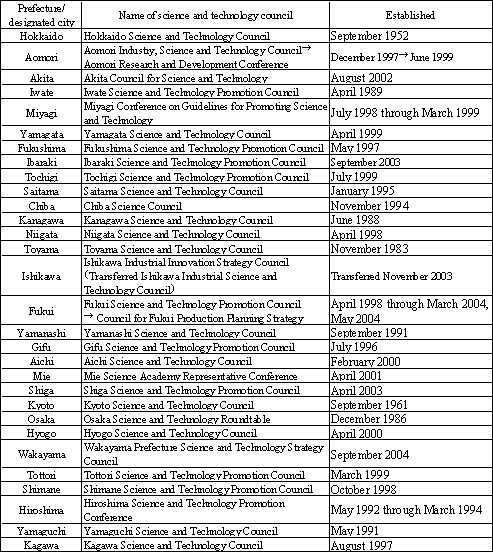
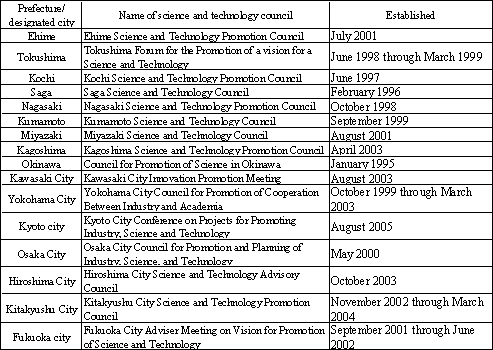
Table 3-3-12 Enactments of science and technology promotion policies by local governments
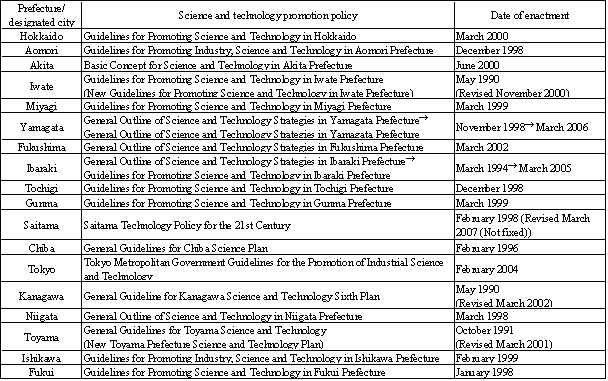
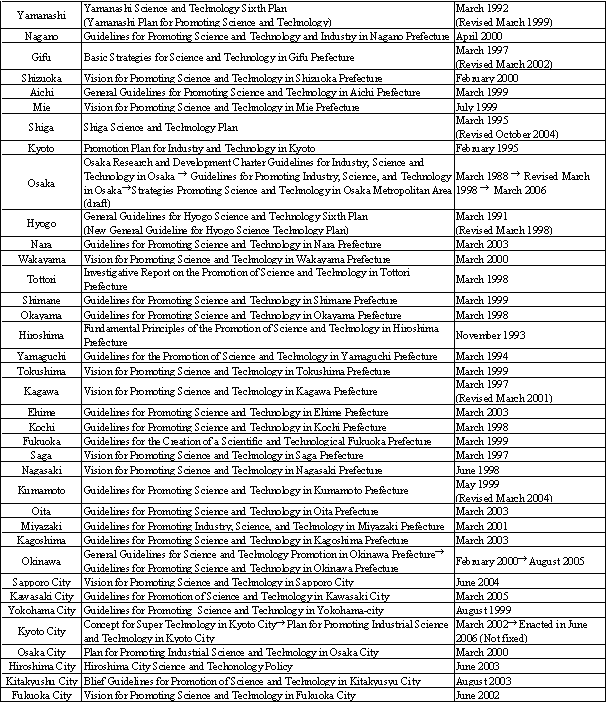
The Second Science and Technology Basic Plan calls for the government to promote research and development activities, including joint research, to develop and retain human resources, and to expand technology transfer functions, etc., for the effective and efficient creation of Knowledge Clusters under local initiatives. In response, the Ministry of Education, Culture, Sports, Science, and Technology launched the “Knowledge Cluster Initiative” in FY2002.
The following sections provide overviews of various policies that are being taken by the national government to support the promotion of science and technology at the regional level.
3.3.3.1 Aiming Toward the Creation of Knowledge Clusters and Industrial Clusters
(1) Knowledge Cluster Initiative
A “Knowledge Cluster” is a local technological innovation system organized around universities and other public research institutions that have unique R&D themes and potential. Businesses located inside and outside various regions are also expected to enter into these systems. More specifically, these systems successively drive technological innovation and create new industries through mutual stimulation between technological seeds in research institutions and practical needs in the real business world. Human networks and joint research entities are also expected to be established in this process.
The Ministry of Education, Culture, Sports, Science and Technology launched the Knowledge Cluster Initiative in FY2002. In FY2004, the project was being run in 18 regions nationwide. In specific terms, each region sets up a “Knowledge Cluster Headquarters” staff with specialist science and technology coordinators, utilizes advisors such as patent attorneys, and carries out industry-academia-government joint research at university research centers or other institutions, which are expected to produce new technological seeds in accordance with industrial needs (Figure 3-3-16). In FY2005, MEXT is working to strengthen its coordination with the Industrial Cluster Project conducted by the Ministry of Economy, Trade and Industry, and supporting personnel development in the field of regional science and technology. The Ministry is conducting interim evaluation on the starting regions for the first fiscal year as well as review of project planning and budget allocation in accordance with the interim evaluation. In addition, the Cooperation for Innovative Technology and Advanced Research in Evolutional Area (CITY AREA) program was implemented in FY2002 and was implemented in 50 areas by the end of FY2005. This program aims to grow the seeds of new technologies by using the “wisdom” of universities, creating new enterprises, and fostering regional R&D-based industries while attaching importance to the unique characteristics of local areas and cities. Among areas where projects are completed, 5 regions that made especially outstanding results have been running the “development-type” as a model project since FY2005.
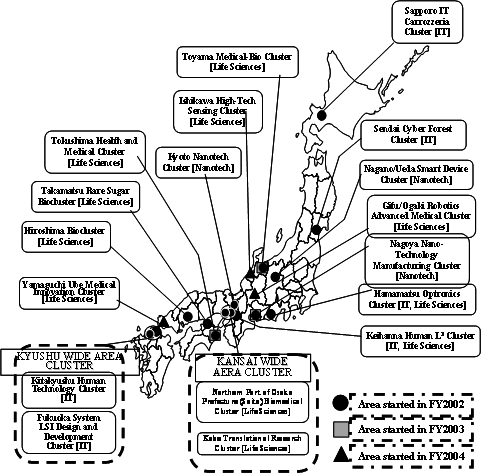
Figure 3-3-13 Map of the Knowledge Clusters
(2) The Industrial Cluster Project (Project for Regional Regeneration and Industrial Clustering)
An “Industrial Cluster” is a system that takes the technological innovation of universities and other public research institutions, and of business enterprises in the surrounding area, and encourages wider area cooperation between the universities, etc., and the business enterprises, and between different enterprises, to create a chain reaction of innovation and creation of new businesses and industries.
The Ministry of Economy, Trade, and Industry’s “The Industrial Cluster Project” involves the regional bureaus of the Ministry of Economy, Trade, and Industry as the hubs of the formation of wide-area human networks of industry, academia, and government, including local enterprises, universities, etc., aiming for participation in world markets, and that uses comprehensive and effective implementation of the Ministry’s regional measures to support local economies and form industrial clusters that can foster new business enterprises capable of competing in worldwide markets. Specifically, the Ministry currently has 19 such projects around Japan, operating with the cooperation of local public authorities, each forming wide-area personal networks of industry, academia, and government that include 6,100 small and medium-size companies with ambitions to enter world markets, and about 250 universities. These projects are implemented to promote improvements in the quality and volume of information flowing among industry, academia, and government, to supplement business management resources with information about technology, business management, and marketing channels, to support technology development that brings out local characteristics, and to develop entrepreneurial fostering facilities (business incubators) and business environments.
Support for technology development in local areas that leads to practical applications and the development of business incubators will be effective in promoting structural reform of industry and revitalizing the economy, by boosting industrial vitality and creating new business enterprises that will lead to the medium and long-term creation of industry and employment. Outlays of 48 billion yen from the FY2005 initial budget have strengthened measures related to the “The Industrial Cluster Project,” centering on support for technology development in local areas that leads to practical applications. So far, a promotion organization was developed for each project, networks formed among industry, academia, and government, and efforts moved forward to develop technologies that lead to practical applications (Table 3-3-14).
Additionally, subsidies are provided to a promotion organization and other organizations (core organizations) which are supporting the creation of new enterprises through the formation of human networks in certain regions and sectors, and the deployment of cluster managers who comprehensively coordinate each cluster’s activities.
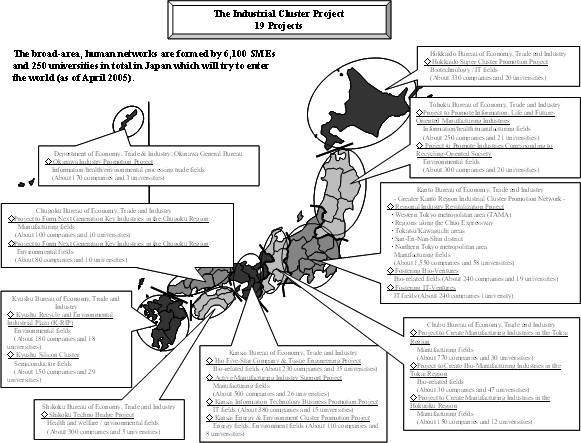
Figure 3-3-14 The Industrial Cluster Project
(3) Coordination between the Knowledge Cluster Initiative and the Industrial Cluster Project
The Ministry of Education, Culture, Sports, Science and Technology is working to create new technology seeds by promoting joint research among industry, academia, and government in fields of creative basic research, focusing on universities and public research institutions in regional areas. The Ministry of Economy, Trade and Industry is working to open up new fields for businesses, and to create start-ups and new products by promoting collaboration projects among industry, academia, and government, such as technology development that leads to practical applications, focusing on business enterprises. Both ministries work together to promote the development of systems of collaboration among industry, academia, and government in regional areas, and both aim to revitalize regional economies and stimulate Japan’s national economy by working in close coordination to supply feedback on market needs and provide new technology seeds through their programs, which are adjusted to be in close coordination. Specifically, the Ministry of Education, Culture, Sports, Science and Technology, the Ministry of Economy, Trade and Industry, local public authorities, and other relevant entities are holding the “Committee for Regional Cluster Promotions” for each region, and joint conferences to announce both ministries’ project results. Furthermore, in continuity with FY2004, the ministries held a nationwide symposium to announce summarized versions of the achievements of such projects, as well as a “Regional Clusters Seminar” and “Nationwide Knowledge and Industrial Clusters Forum” to discuss methods for promoting cluster policies in regions across Japan with Nihon Keizai Shimbun, Inc. being invited as a new co-organizer in FY2005. In addition, close collaboration among ministries and agencies concerned is being promoted through the “Coordination Program for Science and Technology Projects” of the Council for Science and Technology Policy and the “Inter-Ministry Liaison Conference on Regional Science and Technology” and the “Regional Block Conference on Regional Science and Technology.” Moreover, the “Conference on Promotion of Regional Science and Technology” hosted by the MEXT and Tokushima Prefecture in FY2005, the hosts, co-hosted ministries, and co-hosted agencies exchanged opinions between the government and regions in order to make them reflected in the Third Science and Technology Basic Plan. Thus, collaboration is being enhanced.
3.3.3.2 Various Policies on the Promotion of Regional Science and Technology
The relevant national government ministries are implementing a variety of measures aimed at promoting regional science and technology (Table 3-3-15). The following sections introduce some of the main examples concerning research activities conducted by each government ministry.
Table 3-3-15 Major regional science and technology promotion measures
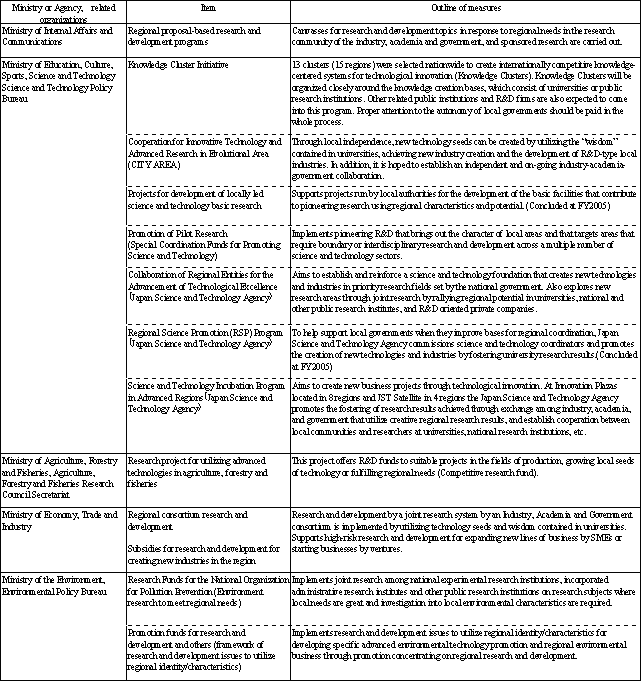
(1)Research programs, etc.
To implement basic and pioneering research and development that fulfills regional needs and potential, it is important to promote coordination and exchanges among industries, academia, and governments. For this reason, it is necessary to develop a diverse range of research programs and to strengthen the coordination functions for research and development. In this regard, government ministries have implemented the following research programs.
1) Ministry of Internal Affairs and Communications
The regional information and communications technology promotion-style R&D in the Information and Communications R&D Promotion Program is promoting joint research in the information and communications field between small and medium-sized enterprises and universities engaged in research and development contributing to the creation of local-based new industries, the promotion of local industries or the reinvigoration of local communities.
In order to support the independence and social involvement of the elderly, the National Institute of Information and Communications Technology (NICT) seeks the cooperation of local government authorities and implements research and development that is aimed at establishing telecommunications systems with advanced features that are sought within the welfare sector.
2) Ministry of Education, Culture, Sports, Science and Technology
Functioning as joint research among industry, academic and government focusing on individual research and development topics with a high necessity of practical application at the regional level, the Collaboration of Regional Entities for the Advancement of Technological Excellence is being implemented. The program aims to conduct R&D leading toward commercial application, which will contribute to the creation of new technologies and industries, such as the development of prototypes based on technological seeds created from basic research by universities, etc.
3) Ministry of Agriculture, Forestry and Fisheries
In order to promote technology development directly related to agricultural production, the Ministry of Agriculture, Forestry and Fisheries implements research to promote key agricultural technology systems at the regional level, through large-scale and integrated research that includes on-site verifications in paddy fields.
In FY2002, the Ministry began implementing a project that invites proposals from the public. Relying on local initiative, the “Project for Research Advancement in Agriculture, Forestry, and Fisheries Utilizing Advanced Technologies” aims at rapid promotion of experimentation and research in the agriculture, forestry, and fisheries sector that has real relevance to working sites.
4) Ministry of Economy, Trade and Industry
In order to create new regional industries and businesses, and to revitalize regional economies, advanced R&D for practical application is being implemented under a strong joint industry-academia-government research system (regional rebirth consortium) utilizing seed technologies and knowledge of universities, etc. In addition, the Ministry is implementing projects to support medium- and small-sized corporations’ advancing into new sectors, and high-risk R&D by entrepreneurial ventures aiming to create new businesses.
5) Ministry of Land, Infrastructure and Transport
In order to facilitate coordination between industry, academia and government in various research and development programs that will contribute to the enhancement of international competitiveness, the realization of a safe and secure society, and solution of environmental problems, and to further promote the utilization of research results, the Second Advanced Technology Forum for Land, Infrastructure, and Transportation was held in Nagoya in February 2006, with 441 representatives of local industry, academia, and governments, as well as representatives of the Ministry and relevant research institutions attending. At the forum, the Ministry’s pioneering research results and intellectual property, etc. were introduced, and the participants had face-to-face dialogues.
6) Ministry of the Environment
The Ministry implements the Regionally Linked Environmental Research Program, which carries out joint research with national research institutions, incorporated administrative research institutions, and public research institutions. This program focuses on research themes for which there is strong demand at the regional level, and which require study that matches the characteristics of the regional environment. In order to help develop and disseminate environmental technologies in specific terms, and promote global environment business by focusing on the promotion of regional R&D, the ministry is implementing R&D projects utilizing regional uniqueness and their characteristics.
(2) Promotion of Technology Transfers at Innovation Plazas (Science and Technology Incubation Program in Advanced Regions)
The Japan Science and Technology Agency (JST) aims to create new business projects through technological innovation. At Innovation Plazas located in 8 regions and JST Satellites in 4 regions, JST promotes the fostering of research results achieved through exchange among industry, academia, and government that utilizes creative regional research results, and establishes cooperation between local communities and researchers at universities and national and public research institutions.
(3) Strengthening the Activities and Functions of Public Experimental Research Institutions as R&D and Technology Support Organizations
In order to provide R&D and technology support, etc., that leads to the advancement of industries and academia at the regional level, the relevant government ministries are implementing various measures directed at public experimental research institutions. These measures are summarized in Table 3-3-16.
Table 3-3-16 Strengthening of the activities and capacities of research and development and technology support functions at public research institutions
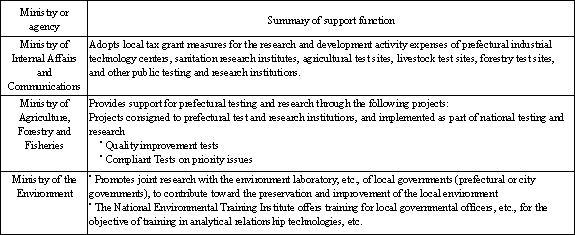
(4) Interregional Coordination and Exchanges
The following measures are being implemented in order to encourage coordination and exchanges between the national government and local government authorities, as well as between different regions.
● Research exchange and other programs of the Japan Association for the Advancement of Research Exchange Cooperation
The Japan Association for the Advancement of Research Exchange Cooperation (JAREC) was established in June 1992, based on funds provided by local government authorities, with the aim of supporting research exchanges and promoting regional research about S&T. This association implements various research support programs and nationwide research exchange programs for regions commencing cutting edge or basic research.
● Industrial Technology Liaison Council
The Industrial Technology Liaison Council was established in 1954 in order to strengthen cooperation among public research institutions and/or with national research institutions in relation to mining and manufacturing technology, to effectively promote experiments and research between institutions, and thus to improve industrial technologies. The council is composed of seven liaison divisions, eight regional councils, and a welfare technology division that is a horizontal organization. The council serves to facilitate research cooperation, research coordination, research exchanges, and information exchanges among public research institutions as well as between public and national experimental research institutions.
3.3.3.3 Supporting the Concentration of R&D Functions
Policies aimed at the promotion of industry in order to invigorate regional areas have hitherto tended to concentrate on enticing corporations to locate to that area, and on the incidental development of roads, harbors, and other hard infrastructure in the surrounding environment. In recent years, however, this approach has been supplemented by measures supporting the development of research equipment, research facilities and other items in the target regions, and the provision of subsidies and other measures for research and development. The following laws and measures represent an integrated approach to supporting the concentration of research and development functions.
3.3.3.4 Consolidation of R&D Bases
The current national comprehensive development plan, known as the “National Grand Design for the 21st Century,” places priority on networking and R&D investments directed at organizations representing industry, academia, and the government. The plan promotes the development of the Tsukuba Science City and the Kansai Science City, and sets forth the development of new research and development bases of an international standard that will serve as the nucleus for the establishment of far-reaching international exchange parks.
(1) Tsukuba Science City
Tsukuba Science City was created as a base to provide research and education of a high standard, and to contribute to the balanced development of the entire Tokyo metropolitan area. It was constructed also as part of a national government policy, in order to promote science and technology and enrich higher education.
Thirty-three national experimental research and education institutions are located in the city, and many private-sector research institutions are also moving in.
Various measures are currently being promoted to develop urban environments, to encourage science and technology, and to form bases for the creation of new industries both in Japan and abroad.
(2) Kansai Science City
The Kansai Science City is a part of Kyoto, Osaka, and Nara prefectures, and seeks to establish a base for new advancements in culture, science, and research of a creative and international nature that will extend across the 21st century.
The city is experiencing steady development in construction in accordance with the Kansai Science City Construction Promotion Law enacted in June 1987. At the end of FY2005, a total of about 250 facilities, including private sector research facilities, were established and operating within the city.
Contacts
Research and Coordination Division, Science and Technology Policy Bureau
(Research and Coordination Division, Science and Technology Policy Bureau)




